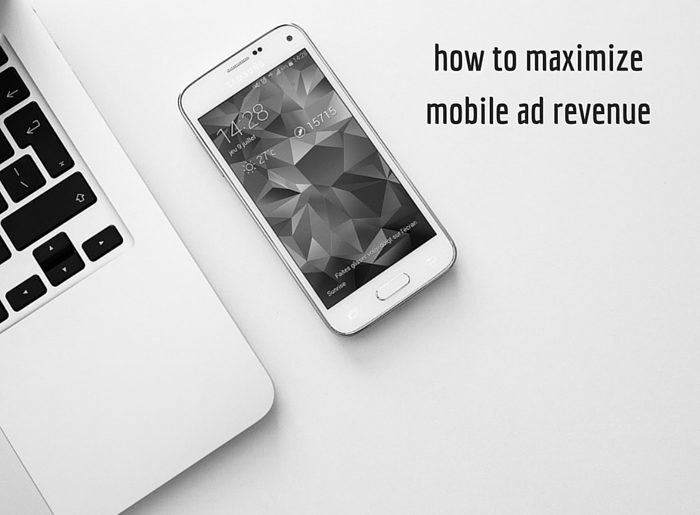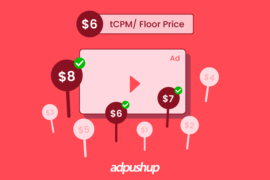These days, sites not only have to be mobile-friendly, but in order to maximize ad revenue, they have to optimize the way ads are served on mobile devices.
It’s impossible to ignore mobile optimization as a website owner or publisher now — you get penalized not just by your users but also search engines. Sites not only have to be mobile-friendly, but in order to maximize ad revenue, they also have to optimize the way ads are served on mobile devices.
A lot of the changes you need to make as a mobile publisher are similar to the ones found in desktop ad optimization strategies.
1. Use Multiple Ad Networks
The majority of mobile ad networks don’t guarantee 100% fill rates. Working with just one ad network means that impressions may go unfilled, leaving potential ad revenue on the table.
How many ad networks should you use?
A general rule of thumb is to use 4 or 5 networks to display your ads. With an increased fill rate and a diverse set of advertisements shown, you’ll boost your revenue without making major changes in the process.
Mobile ads aren’t immune to poor performance. An ad network may have CPC or CPM rates fluctuate as much as 20% from one day to the next. Offers may also have their rates decreased, leaving you will less valuable traffic.
Utilizing and monitoring ad networks will safeguard you against these massive income fluctuations.
A few mobile ad networks we recommend are:
2. Enable Geotargeting
Your site’s visitors may come from the United States, Australia, India, or over a hundred different countries. Certain ad networks target specific regions. For example, your site’s visitors may be predominantly from India, so an ad network that caters to your users is the ideal choice.
Not only will you earn more revenue, but you’ll be displaying highly-targeted offers to your users.
If you have traffic from non-English speaking countries, it’s important to try and set geographic regions for your ads. Your ad network representative will be able to help you determine which geographic targeting regions will be best for your traffic based on past performance data.
3. Adjust Ad Frequency Caps
Ad networks are not created equal. If you have a high-traffic website, you’ll find it difficult to test different ad networks while not losing revenue in the process. Poor performing networks will cause your revenue to drop, but testing needs to be conducted to judge how a network performs.
This is where frequency capping comes in.
Frequency capping is a feature that limits the number of times your ads appear to the same person on the Display Network. Frequency is the average number of times a unique user sees your ad over a given time period.
Utilizing ad frequency caps will allow you to test a network without losing money in the process.
Taking a systematic approach to ad testing takes a lot of time and patience, but here’s how you can go about it:
- Determine the hours where revenue or visitor numbers are currently high.
- Implement new ads during peak hours to test their performance.
- Run ads over the span of weeks to test ads over the long-term.
- Integrate ad frequency caps by mixing in proven networks with new networks currently being tested.
Ad frequency caps allow you to test ad networks while maintaining revenue figures. If an ad network is performing well, caps can be removed to see how well they perform when you divert more traffic to the network’s offers.
4. Set Up Ad Refreshing
Reloading ads without refreshing the page is a popular method of ad optimization in the mobile world. The trick is to choose an ad refresh rate that allows users to:
- See the ad.
- Have an opportunity to click on the ad.
Many experts recommend refreshing ads every 2 minutes to allow viewers the opportunity to click on the offer. If you have a site with little content, you will want to adjust and test these numbers to find the best choice for your site.
Refreshing ads allows you to place more offers in front of a viewer.
When implementing this technique, make sure that the ad networks you use allow ad refreshes. Google AdSense, for example, has strict rules that only allow ad refreshes if they’re user initiated.
5. Repeat Ad Units
Psychologist Robert Zajonc discovered the mere-exposure theory. This is a theory that all publishers should know about. The study demonstrated that mere exposure to a character provided participants of the study with a positive association to the character.
What does this mean for a publisher? If a visitor sees an ad, they’ll subconsciously associate it with a positive meaning.
The more that the ad is seen, the more a user will associate it with a positive meaning. Visitors that haven’t clicked on an ad may click in the future because their interest is piqued each time the advertisement is viewed.
This is a smart choice for banner ads.
By repeating the same ad unit, you’ll increase exposure to the ad, and users will be more inclined to click if the offer is targeted to them.
6. Adjust Ad Sizes for Better Performance
Smartphones and tablets vary greatly in screen size. These variations have led to the creation of a myriad of unconventional ad formats for publishers to test and integrate into their websites.
But, what ads perform best?
MediaLets provides insights into ad performance. This particular report is from Q3 2014, and analyzes 240 billion data points to provide data on the highest-performing ad sizes for mobile.
What sizes are recommended for the highest conversion rates?
- Handsets: The mini-leaderboard (320×50 and 300×50) and the medium rectangle (300×250) performed the best on handsets.
- Tablets: The leaderboard portrait (768 x 90), leaderboard landscape (1024 x 90) and the half-page (300×600) perform the best.
Another interesting tidbit is that tablets have a 2.7-time higher conversion rate than smartphones, so if you have a lot of traffic from tablets, you can use this statistic to boost CPA ad revenues greatly by optimizing unit sizes for tablets.
All this said, there’s no substitute for testing your ad units.
7. Set Up Mobile Anchor or Interstitial Ads
Traditional banner ads aren’t the only ads you should be showing on your site. New ad formats allow you to minimize ad blindness, and you’ll find that newer ad types often produce higher revenues – at least initially.
Two ad types that you should experiment with are:
- Mobile Anchor Ads
- Interstitial Ads
Mobile anchor ads are normally smaller leaderboard ads that are docked or attached to the bottom of the viewing screen. When a user scrolls, the ad remains at the bottom of the screen, increasing visibility.
Google was one of the pioneers of mobile anchor ads, and now several ad networks offer similar ad types.
Interstitial ads are also popular among mobile publishers because they’re impossible to miss. These ads span the entirety of a viewer’s screen, eliminating ad blindness and increasing conversions. While not all audiences will respond well to this ad type, the CPM is usually very high, with rates of $4 – $15 on average.
If your viewers aren’t responding well to your current ads, give anchor and interstitial ads a try.
8. Conduct A/B Testing
Statistical analysis allows publishers to earn the most revenue possible by analyzing their own site’s data over a specific period of time. Through A/B testing or split testing, you’ll be able to test different ad sizes, types or even just colors to boost your revenue.
Small, incremental changes are what A/B tests allow.
A few simple tests that can be conducted are:
- Image vs text ad performance.
- Ad placement and positioning.
- Ad size performance.
- Color scheme differences.
Split testing needs a lot of data to be accurate.
It may be tempting to remove a particular ad size because it performed poorly for the first 12 hours of the day, but you want data over the course of a week or a month for a true metric of performance.
Fluctuations in traffic or user behavior need to be negated, so all testing must be done over a course of days and not hours for any useful conclusions.
9. Machine Learning Optimization
Smart layouts or machine learning is a computational way to optimize your revenue. This is often done through a third-party service. What this does is:
- Test various ad units to find the optimal choice for your site.
- Adjust ad unit sizes and placement automatically based on data received.
- Continually monitor ad performance and adjust automatically to optimize CTRs.
Over time, machine learning or smart layouts will evolve with your traffic to help boost revenue and weed out low-performing ads and sizes.
It’s the hands-off approach to optimizing ad revenue.
10. Implement Native Ads
Ads are becoming less and less profitable because site visitors are becoming more and more ad blind. Sure, you can place an interstitial ad on the screen or a “sticky” ad that attaches itself to the bottom of the screen, but you’ll always risk lowering your site’s user experience in the process.
Chances are if you don’t appreciate a full-screen ad, neither will your users.
As a website owner who relies on ad revenue to remain operational, this leaves you scratching your head on what to do to and how to boost revenue.
Native ads are the obvious answer.
If you’ve recently been on Facebook and found an ad on your feed that looked just like a post from a friend (it blended with the site’s design), this is exactly what native advertising is all about.
And, so far, native advertising has performed far better than banner ads and other ad types.
There are three native ad types to try:
- In-stream: This can only be used on certain site types, but a good example of this would be sponsored stories on Facebook or sponsored tweets on Twitter.
- Activity-triggered: After a user performs a specific action, they’ll receive an ad that is displayed.
- Branded Content: Branded content is content that is curated by a brand and distributed to other outlets.
Native ads are harder to implement because they must match your site’s form and function to perform properly.
You can also optimize native ads to make them perform even better for your site and users. Here are some native ads networks that you can consider.
FAQs
Ad revenue is the income you can earn from advertisements appearing on your content. Websites, videos and social media platforms can display these ads. Including ads in videos and web articles is what allows the content to be free, just like in magazines and on TV.
These are some benefits of earning ad revenue:
i. Simple process
ii. Easy to increase
iii. Attracts viewers
iv. Adds to diversification
A variety of factors affect CPM and CPC, such as target audience demographics, niche, supply and demand, ad network, and season, when it comes to monetization. Traffic and targeted audience will determine ad impressions and clicks. Revenue increases with higher CPM, CPC, and traffic.
A growth blog for professional bloggers and ad ops professionals.








